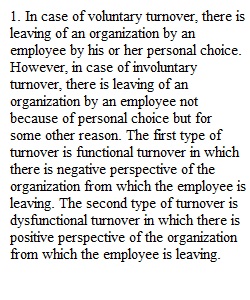


Q ZOOM Chapter 11 Questions Answer the following items and upload your responses to the appropriate drop box by the due date.1. What is the difference between voluntary and involuntary turnover, and what are the two types of voluntary turnover?2. What are the exceptions to the employment-at-will doctrine?3. How do the principles of justice relate to employees satisfaction in the workplace?4. What is the WARN Act, and to which organizations does it apply?5. What is the difference between progressive discipline and the hot-stove rule? Provide at least two examples of workplace behaviors that would be subject to each of these approaches.6. What is the difference between mediation and arbitration?7. How do the antecedents affect job dissatisfaction, and why is tracking satisfaction/dissatisfaction important?8. How does satisfaction/dissatisfaction affect employee behavior?9. Which of the recommendations for increasing job satisfaction do you feel would be most effective, and in what context?10. Why do employers conduct exit interviews?
View Related Questions